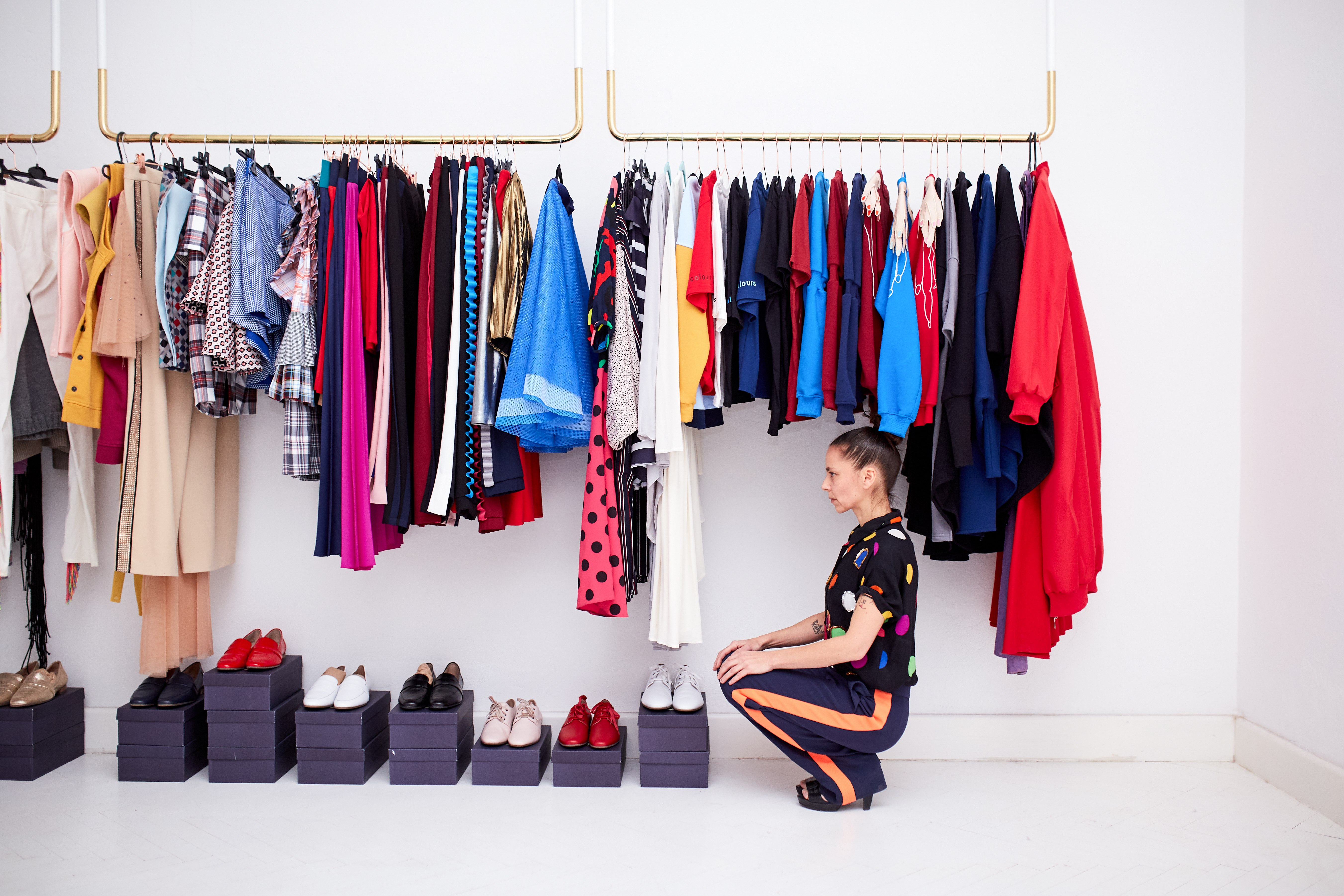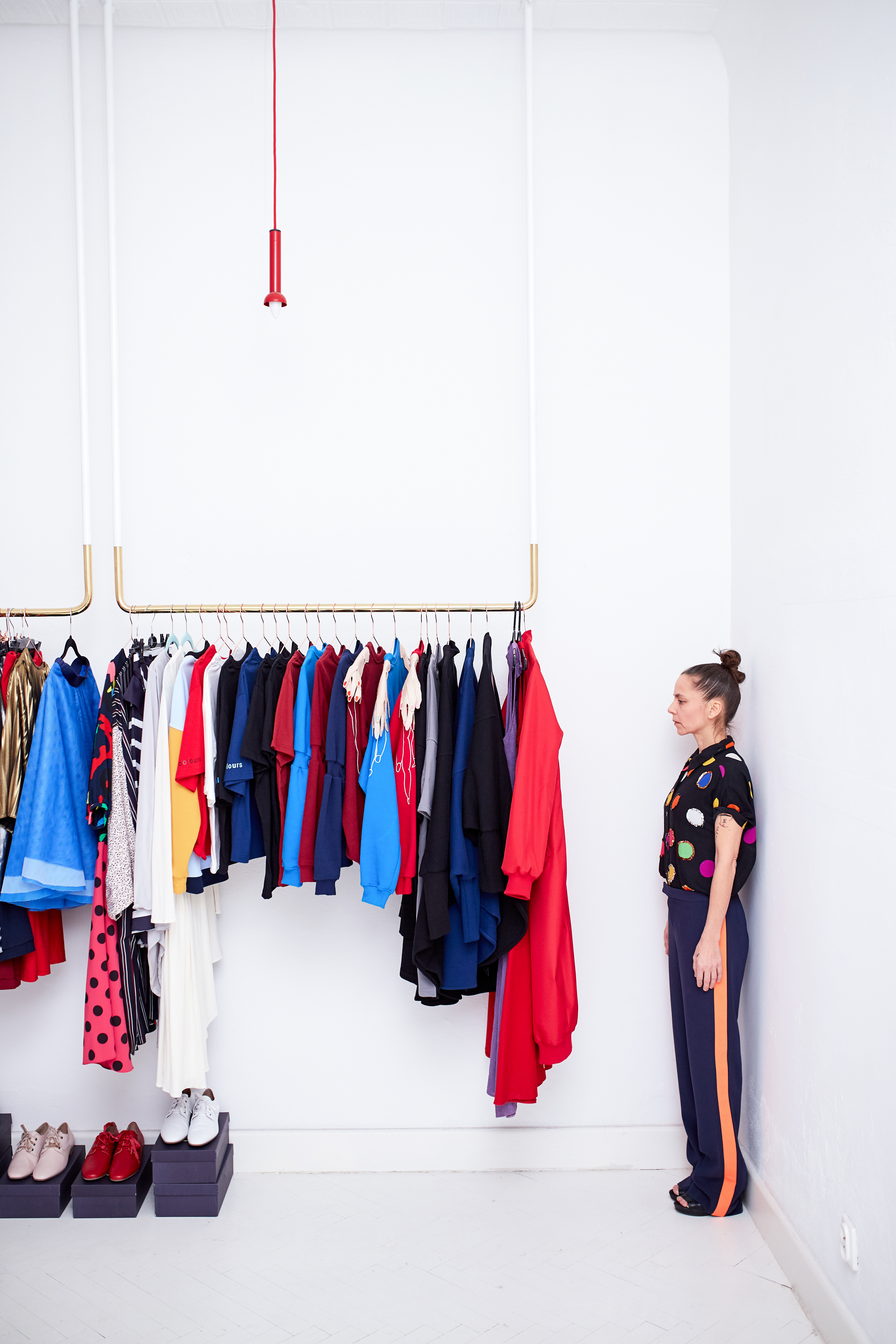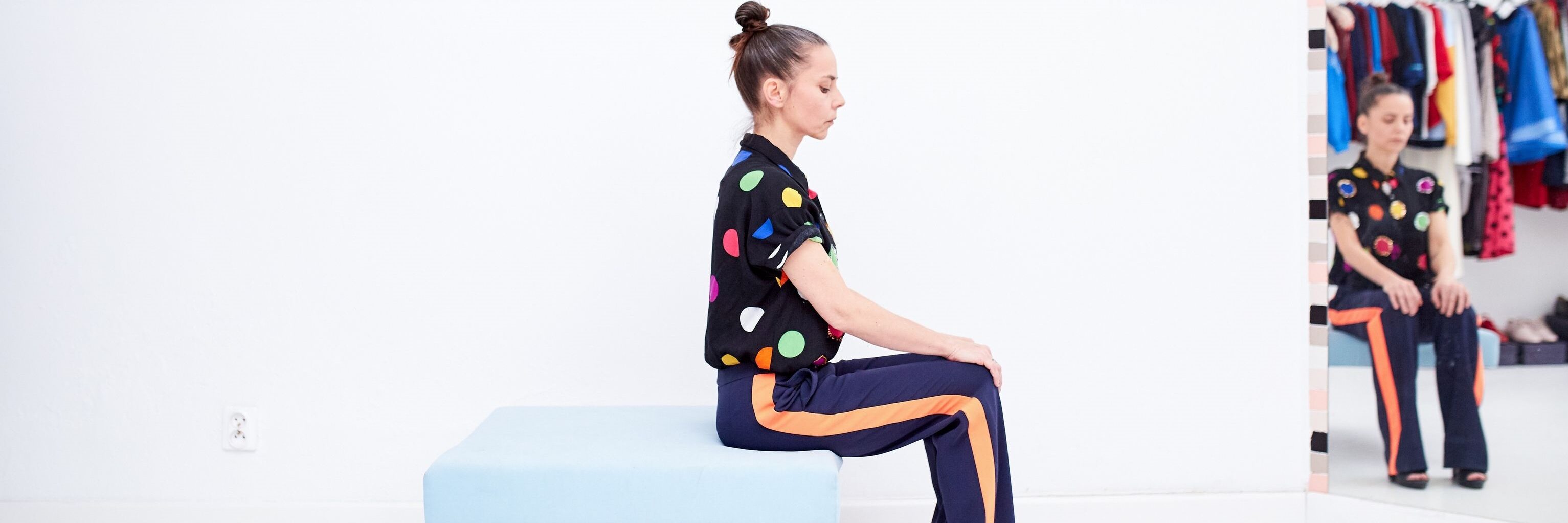She is known for extraordinary ideas and a passion for expressive colours and geometric patterns. Until recently, Vasina has been referred to mainly as a star stylist, and she was most recognized as the author of Monika Brodka’s subsequent makeovers. Marcin Szczelina talks with the designer about fashion shows and their role in the world of fashion.
Marcin Szczelina: I’ve heard you had a concept for your first show, organized in September 2018, for quite a while. How was it different from the fashion shows the audience is used to?
Vasina Maćkowiak: What made it stand out was the fact that it took place during the day. In Poland, this doesn’t happen very often. Fashion shows are usually held in the evenings; I wanted to make an event focused strictly on fashion. It was intended for people truly interested in the new collection and in clothes. I didn’t want to organise yet another event with fashion only as an additional element. And it worked! Although I don’t want to suggest that I’m the only designer who has organised a daytime show – for instance Ania Kuczyńska has done it before.
What do you think about the style of fashion shows: glamour, lots of champagne, celebrities in front rows, waiting for VIPs to even start the show? Is this what you wanted to avoid?
I want to do things differently. To be honest, it’s a bit easier for me now because we’re living in different times. Today, Polish fashion is far better received, and, above all, people really buy it. Before, it almost didn’t sell. Therefore, such events were not proper fashion shows, but rather large projects organised in spectacular settings, and their main purpose was to please the sponsors. These were shows for the sake of shows. And I am trying to do it my way, although it’s often challenging. There’s still a lot that needs to change in Poland.
What do you mean?
First of all, I’m talking about the way people think about fashion. I would love to see this fashion sell, and the shows to be organised with the customer rather than celebrities in mind.
Are customers in Poland ready for such a change?
I have no idea.
I get this impression, and this is not only my opinion, that what sells are above all elegant tulle evening dresses…
It’s hard to say how other designers’ collections are selling. Although I must admit that the number of evening gowns compared to the number of galas and big events that are organised in Poland is, to say the least, inadequate. In other countries it’s unlikely to see an A-list celebrity come to a fashion show in an evening gown. After all, these shows are not for the guests to show off, but for models to showcase designers’ collections. Only in Poland do we have such bizarre fashion show habits.
Why is that?
Let me put it this way: this is the “legacy” of the old days, when fashion-related events were really a huge thing. Attending them was a bit like going to a circus – you didn’t go there to write about fashion. Anyway, what do we see even today when we open a glossy magazine? Step and repeat everywhere. Perhaps this is because readers don’t really care what the designer has to say, they just want to see what their favourite celebrity wore this time.


You said you wanted to do it differently. How would you like to state your presence on the Polish market?
In the way that fashion showrooms are treated around the world. People who attend fashion shows are boutique owners and customers, either waiting for a new collection or cooperating with the designer. I have an online store, where I offer short production series from my seasonal collection – not all of it, obviously. I started with the Spring/Summer 2019 line and I’m developing the concept in baby steps.
My plan is to release a Vasina Studio fashion show collection once a year – this year is the third time I’ll be doing this – and four short capsule series of the Vasina brand for my online store. Each of the fashion show collections will also be accompanied by a photo album for which I will choose 15 protagonists, usually people who surprise or confuse me, whose work I admire or who remain a mystery to me. Each of the limited series albums will have its own main theme.
Janusz Noniewicz told me that in order to be a successful designer in Poland, one has to be a celebrity. When will you start designing tiles for Tubądzin or selling your collection in Biedronka discount stores?
Oh! I would be very happy if I were asked to design tiles. I certainly don’t perceive such a thing as something negative or a stain on my honour. I would definitely rather design tiles than a collection for Biedronka. But I don’t think this is the celebrity aspect Janusz Noniewicz had in mind. Designers simply must be present in public life, because they are their own business cards. This is actually quite a shame as, frankly speaking, I would rather design tiles than pose for a line of photographers. In fact, I don’t know what my reaction would be if Biedronka, Lidl or another discount store chain approached me with an offer.

Are you not tempted to design, for instance, a bed linen collection?
You know, everything can be done well. I would have a different problem with such a proposal, namely the question of quality. I think a more affordable bed linen can be designed as well as a collection you would design for your fashion studio. Unfortunately, the truth is that what is later sold in high street stores is terrible both in terms of the fabric used and the method of sewing. Although there’s nothing wrong with collaborations between designers and retail chains — they happen all over the world.
But they are associated with poor quality.
To a large extent, yes. For example, when I go to the Rossman store, I see such things lying at the back of the shelves, dirty, and made of low-quality fabric. I wouldn’t want my collection to be treated this way. This runs against my brand philosophy even more than the proposal of doing a purely commercial project. That said, I’ve never received such a proposal in my life. Now I may claim that I would answer “Absolutely not”, but I don’t really know how I would react if someone told me “Here is your million zlotys and do what you want”.
Sure, business and art don’t necessarily have to turn their back on one another. Industries need to cooperate, but wisely. Tell me, why did you open your studio in the centre of the city, in a tenement house? Does architecture inspire you?
Yes, definitely. First of all, I love tenements, with their high ceilings and spaciousness. Second of all, I wanted to have a studio close to home, because I usually do a million things at once.
So you live in the city centre as well?
Yes, I live in an old tenement house. Everyone says that this studio looks a bit like my home. And I live three minutes by bike from here, which is a huge time saver. Besides, I love interior design. That is why these tiles from Tubądzin that you’ve mentioned really appealed to me. I would love to have my own collection of interior design items. Actually, it’s my unfulfilled dream, and by decorating the interior of my apartment, I was able to make it reality at least in part.
The word on the street is that you keep in your mobile phone, in the “Inspirations” file, a photo of a fragment of a wall.
That’s right. I often notice details that aren’t related to fashion at all. Frankly, I hardly ever flip through fashion magazines at all, I prefer to observe the street life. This is much more interesting. I am tired and bored with the fashion world.
In this case, which artists or architects inspire you? Do you have any favourite ones that you follow?
Not really. The only thing about me that is related to architecture is my passion for geometry and the fact that I look for balance and harmony in everything I create. I can’t work in a romantic way. I don’t use flounces, and if I do, I really need them to be cut precisely into a square. Neither am I a big fan of nature, I prefer to be in closed interiors. I feel wonderful in a neat flat in a tenement house.
How do you react to the labels that you are tagged with – that of a minimalist designer, one that prefers modest cuts? Doesn’t it worry you that people tend to pigeonhole each other?
If they want to, let them do so. I’m not particularly interested in what others have to say about what I do. Some people like it, others don’t.
In one of the interviews you said: “I suggested purple because I knew that Monika hated it”. Are you a nasty type?
I am. To make things worse, when I come up with an idea, I really have to have it my way. No matter what, I just have to find a way to make it happen; otherwise I won’t sleep at night. But Monika is also nasty, so we get along pretty well.
How come you’ve been on close terms with Monika for so many years?
We have similar personalities and I’m afraid that no-one else would be able to get along with us. We’re stuck with each other. Besides, I met Monika when she was 16 years old and since then we’ve been friends and we’ve been growing and changing together. We also really trust each other, which makes working together so much easier. Although now Monika is largely self-sufficient. I sometimes joke that she knows much more about fashion than I do. She is always up-to-date and follows trends much better than I do.
If someone else, an A-list celebrity, approached you and asked you to style them, I assume you would agree?
Of course.
You once said that one either has style, or one does not, and no stylist can make someone have it.
Yes, and that’s why I can’t work with everyone. I am open to cooperation, but in some cases it turns out sooner or later that I am not able to continue working with certain people because of major differences in fashion tastes or habits. I like to work with people who have their own ideas, and I find it impossible to work with those who don’t know what they want. Not only when it comes to clothes, but in general. I prefer someone with a bad taste to someone cool, but dull.
You have your own studio, you’ve already had several fashion shows, and it’s no secret that you want to make an international career. How are you planning to go about this?
Well, in this aspect at the moment my ambition is bigger than my ideas. I’ll be looking for someone to help me go international, because you need to be very well prepared to take the plunge.
Does it matter to you what fabrics you use in your collections? Do you try to be eco-friendly?
Yes, but in Poland it’s not always easy. For instance, I once ordered organic cotton T-shirts. When one of my corporate clients wanted to place an order for a larger batch of these T-shirts – also because they are made of organic cotton – it turned out that the supplier did not have the necessary certificate. I was told that I could remove the eco-friendly label. That really annoyed me.
Aren’t you tempted to produce materials, such as recycled fabric, yourself?
Inventing materials isn’t a task for designers. It is usually done by technicians who graduate from Materials Science departments. Even if I have an idea for a fabric or material, I won’t have the means to make it.
Many designers in Poland have an almost religious attitude towards clothes. Do you share this view?
No, absolutely not.
Do you think of fashion in utilitarian terms, then?
At this moment, yes. Attitudes towards one’s professional life may change over the course of time, and I also used to think about fashion differently than I do now. When you are young, you experiment and learn from these experiments. The more imaginative you are, the better the outcomes. However, it’s not always possible to later wear such experimental garments. Then you find yourself facing new challenges: you begin to wonder how to make items of clothing that are original and distinctive, and at the same time comfortable and easy to wear.
Without a great philosophy behind it?
Why would I need one?
Everyone seems to have it.
Well, I don’t. I can hardly manage to systematise my own ideas. When I’m designing, it’s a struggle against myself, and not against the world. Apparently, I am not that up to speed with trends.
Where do you see Vasina Studio in a few years?
I would like to open boutiques in Tokyo and New York. That would give me a good excuse to spend time there and take on new challenges.
When will you start designing clothes for men?
When I have a good idea and a customer. Unfortunately, so far when I have been thinking about men’s fashion I’ve only been able to copy other people’s ideas. Although I know that you can design a line of clothes looking at what the men’s fashion market is missing.
And in terms of men’s fashion, the market is quite lacking…
Yes, there’s almost nothing interesting in men’s fashion in Poland.
But you do work with men, for example with Krzysiek Zalewski.
Yes, but this is a different thing – I make stage clothes for him.
You said that you are inspired by people you meet, and by interiors you stay in. And how do you feel in Warsaw? How does this city influence you?
I’ve lived in Warsaw for over 25 years, so by now it’s probably more of my city than Kraków, where I come from. I like Warsaw’s aesthetics, this Varsovian chaos and the pace at which people work here. I like when things happen fast.
I understand that Kraków can be quite annoying in this respect?
I love Kraków, but as soon as I cross the city gates, I feel like going to bed or having a glass of wine on the Market Square. Whenever I’m there, I feel like doing nothing. Warsaw, by contrast, is a bit like New York: it’s stimulating, there are plenty of people engaging in various activities, and this feeds my creativity and spurs me to do cool things.
The interview was published in the first printed issue of Architecture Snob magazine.




